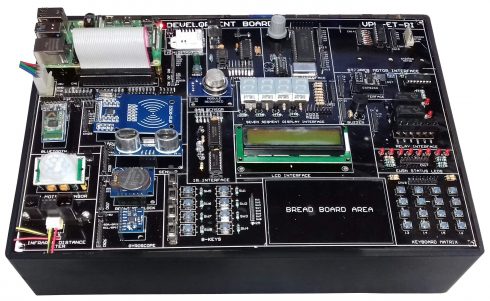Raspberry Pi Board (VPL-ET-PI)
Raspberry Pi Board (VPL-ET-PI) • Processor: Quad-core ARM Cortex-A72 64-bit SoC @ 1.5 GHz or better • Memory: 4GB LPDDR4-3200 SDRAM or better • Wireless LAN: Dual-band 802.11 b/g/n/ac (2.4GHz and 5GHz) • Bluetooth: Bluetooth 5.0, Bluetooth Low Energy (BLE) • Ethernet: Gigabit Ethernet • USB Ports: 2 × USB 3.0, 2 × USB 2.0 • Video Output: 2 × micro-HDMI ports supporting up to 4Kp60 resolution • Audio & Video: 4-pole stereo audio and composite video port • Storage: Micro-SD card slot • Expansion: 40-pin GPIO header (Raspberry Pi HAT compatible) • Interfaces: Camera (CSI), Display (DSI) • Power: 5V DC via USB-C connector or GPIO header (flexible power options)
Hardware Overview
- Processor: Quad-core ARM Cortex-A72 64-bit SoC @ 1.5 GHz or better
- Memory: 4GB LPDDR4-3200 SDRAM or better
- Wireless LAN: Dual-band 802.11 b/g/n/ac (2.4GHz and 5GHz)
- Bluetooth: Bluetooth 5.0, Bluetooth Low Energy (BLE)
- Ethernet: Gigabit Ethernet
- USB Ports: 2 × USB 3.0, 2 × USB 2.0
- Video Output: 2 × micro-HDMI ports supporting up to 4Kp60 resolution
- Audio & Video: 4-pole stereo audio and composite video port
- Storage: Micro-SD card slot
- Expansion: 40-pin GPIO header (Raspberry Pi HAT compatible)
- Interfaces: Camera (CSI), Display (DSI)
- Power: 5V DC via USB-C connector or GPIO header (flexible power options)
Key Concepts – Raspberry Pi Board:
- Embedded Computing: High-performance computing capabilities ideal for home automation, industrial control, and media servers using the ARM Cortex-A72 SoC.
- Wireless Connectivity: Dual-band Wi-Fi and Bluetooth 5.0 enable seamless communication with cloud services, peripherals, and IoT devices.
- Multimedia & Graphics: Supports dual 4K video output, suitable for multimedia applications, digital signage, and advanced graphical interfaces.
- Edge Computing: Local data processing capabilities reduce latency and enhance privacy, essential for real-time analytics, edge AI, and smart camera systems.
- Flexible Expansion: 40-pin GPIO header allows extensive sensor, actuator, and expansion board interfacing for versatile IoT projects.
- Cloud Integration: Compatible with AWS IoT, Azure IoT, and Google Cloud IoT for remote monitoring, data storage, and analytics.
- Power Efficiency: Offers multiple power supply options, ideal for portable and stationary IoT solutions.
Experiment List
- Getting Started with GPIO and Python
-
- Objective: Learn GPIO pin configuration and basic I/O operations using Python.
- Key Concepts: GPIO manipulation, digital I/O, event handling.
- UART Communication Setup
-
- Objective: Configure UART for data exchange between Raspberry Pi and external devices.
- Key Concepts: UART communication, serial debugging, data logging.
- Sensor Integration using I2C & SPI
-
- Objective: Interface and read data from various sensors.
- Key Concepts: Sensor communication (I2C, SPI), data acquisition, sensor interfacing.
- Sensors:
- HTU21 (Temperature & Humidity)
- BH1750 (Light)
- MPU6050 (Accelerometer & Gyroscope)
- MQTT Communication with Cloud
-
- Objective: Publish sensor data to cloud using MQTT.
- Key Concepts: MQTT protocol, cloud integration, IoT data transmission.
- Real-Time Dashboard with Node-RED
-
- Objective: Create a local dashboard for visualizing sensor data.
- Key Concepts: Node-RED, real-time visualization, IoT monitoring.
- Camera-Based Data Logging
-
- Objective: Capture images/video for analysis.
- Key Concepts: Image processing, data logging, storage management.
- Edge AI Model Deployment with TensorFlow Lite
-
- Objective: Train/deploy an AI model for object detection.
- Key Concepts: ML model training, edge inference, TensorFlow Lite deployment.
- IoT-Based Environmental Monitoring
-
- Objective: Collect environmental data, cloud storage, remote visualization.
- Key Concepts: Remote monitoring, cloud storage, real-time analytics.
- Designing a Home Automation System
-
- Objective: Automate home appliances with mobile app control.
- Key Concepts: IoT automation, mobile integration, system control.
- Anomaly Detection using Machine Learning
-
- Objective: Implement anomaly detection in sensor data.
- Key Concepts: Anomaly detection, data analysis, ML application.
- Building a Web Server
-
- Objective: Set up a web server for local/remote IoT data access.
- Key Concepts: Web server configuration, HTTP protocols, data serving.
Platform and Workstation Details
- Training Environment Setup:
- Display: 4 Inch capacitive touch LCD for interaction with the Raspberry Pi system.
- Connectivity: USB OTG, I2C, SPI, UART for various external device interfaces.
- Power Supply: Powered via USB-C or GPIO header, providing flexible power options.
- Enclosure: Plastic or durable case for protecting the board and peripherals in an industrial environment.
- Expansion Options: 40-pin GPIO header allows easy integration with additional sensors, actuators, and peripheral devices.

